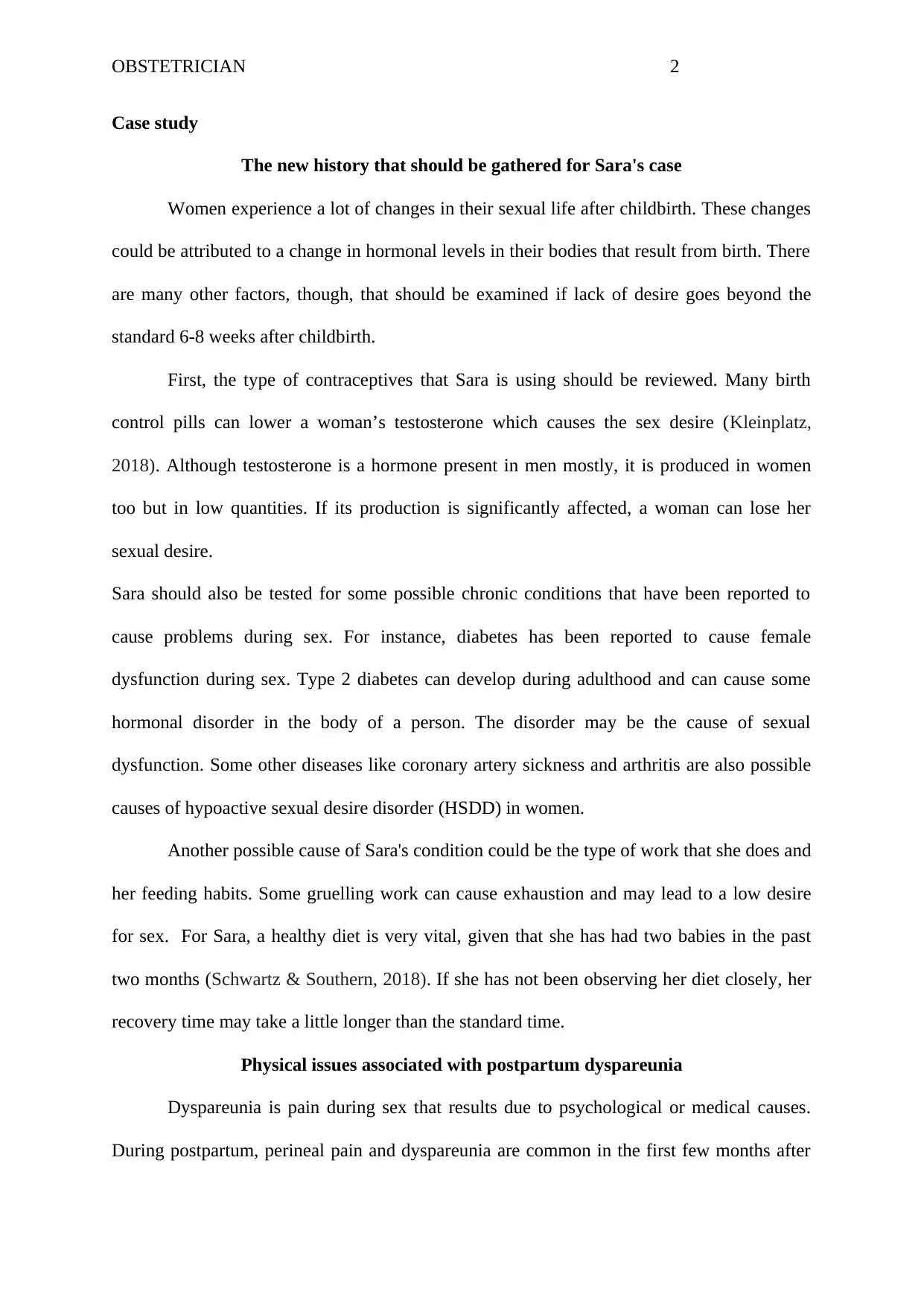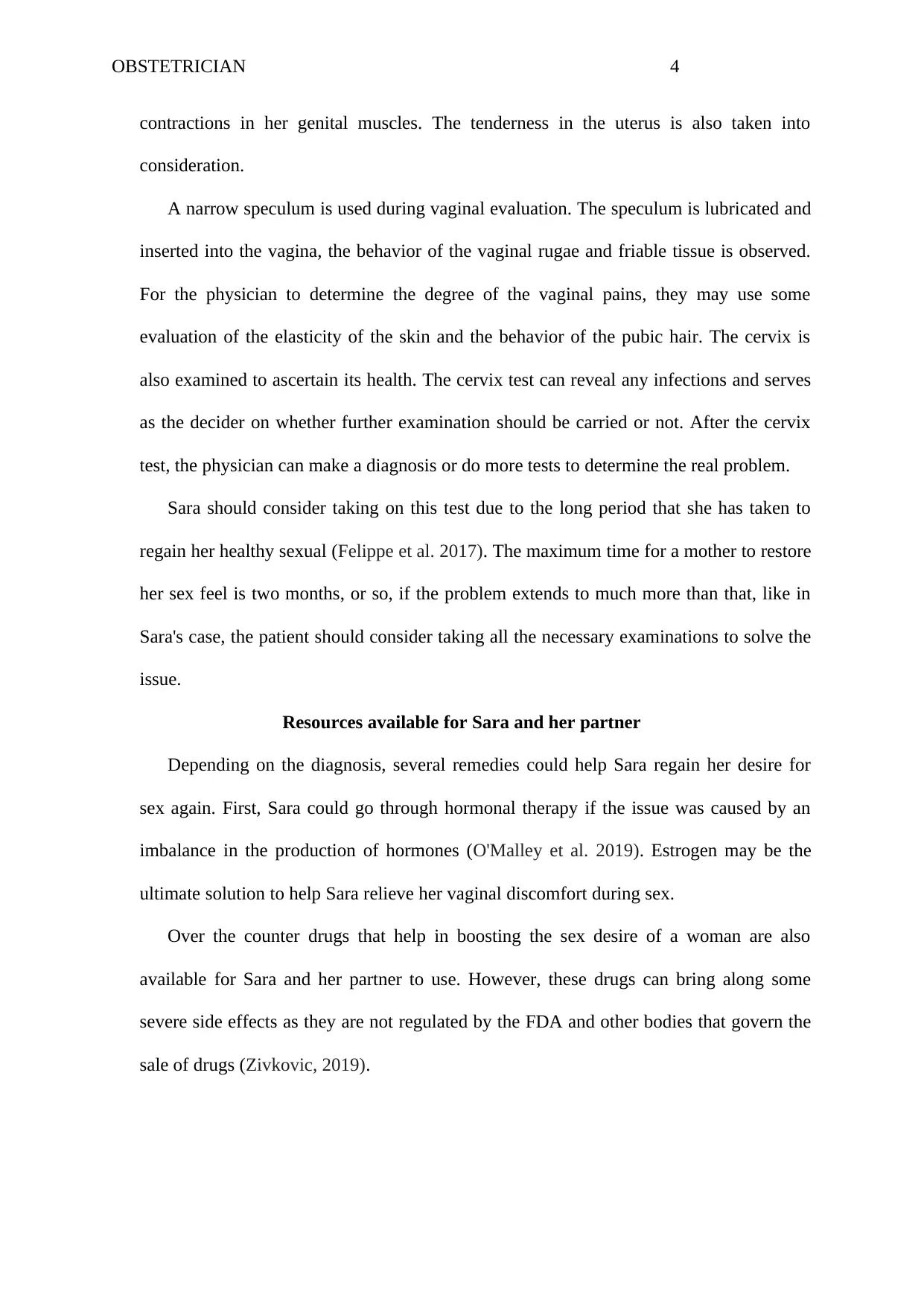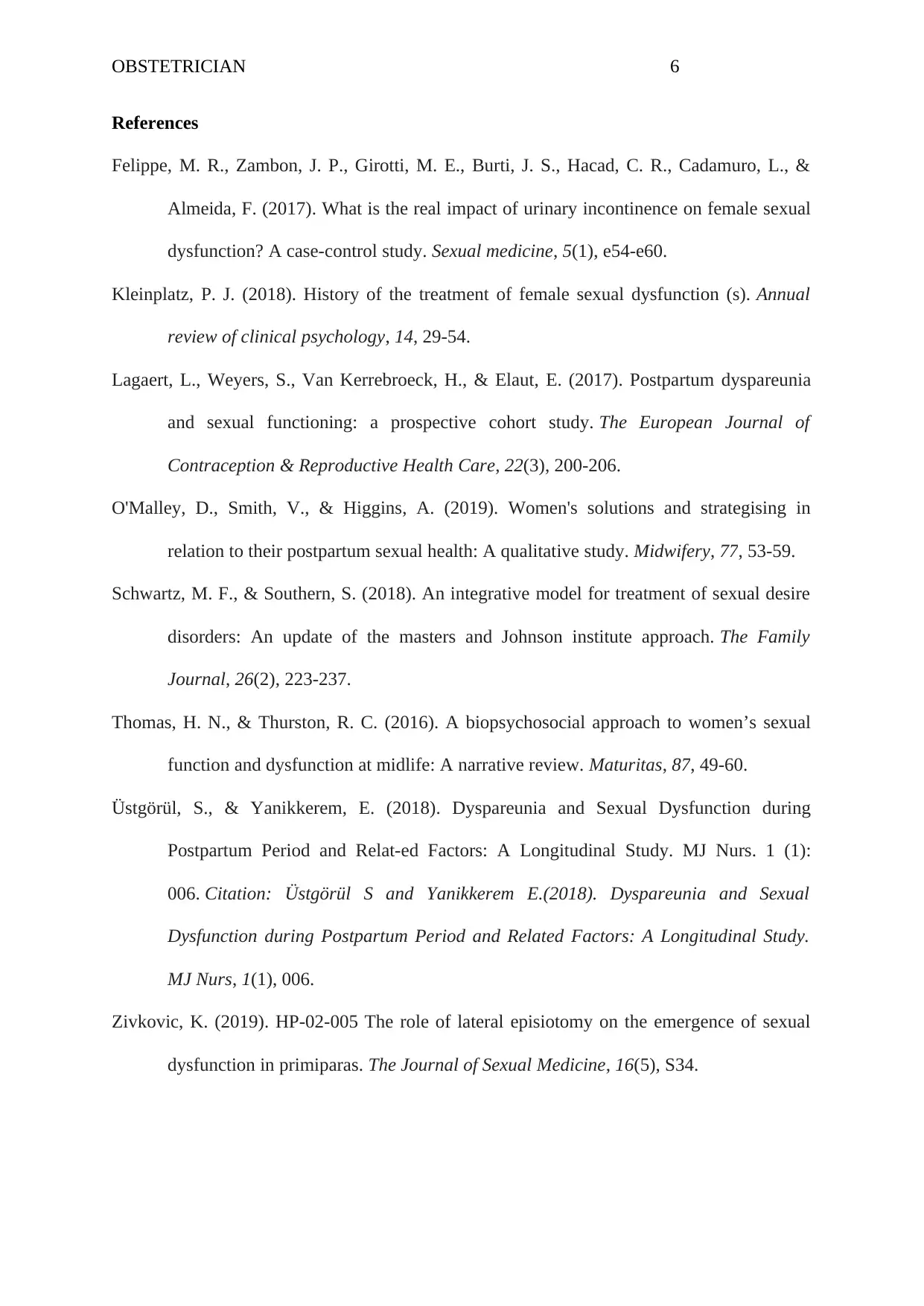Case Study Analysis: Sara's Postpartum Sexual Dysfunction
VerifiedAdded on 2022/08/17
|6
|1486
|19
Case Study
AI Summary
This case study focuses on Sara, a 34-year-old woman experiencing sexual dysfunction 18 months postpartum. The assignment requires gathering additional patient history, discussing physical issues associated with postpartum dyspareunia, describing a physical exam, and identifying available resources for Sara and her partner. The analysis explores the impact of hormonal changes, contraceptive use, and potential medical conditions on sexual desire. It also addresses the causes of dyspareunia, including vaginal dryness, operative vaginal delivery, and episiotomy. The importance of a pelvic exam and other diagnostic tests is emphasized, along with the potential benefits of hormonal therapy, over-the-counter drugs, and lifestyle changes. References are provided to support the findings and recommendations.

Running Head: OBSTETRICIAN 1
OBSTETRICIAN
Name of Student
Name of Professor
Institution Affiliation
Date
OBSTETRICIAN
Name of Student
Name of Professor
Institution Affiliation
Date
Paraphrase This Document
Need a fresh take? Get an instant paraphrase of this document with our AI Paraphraser

OBSTETRICIAN 2
Case study
The new history that should be gathered for Sara's case
Women experience a lot of changes in their sexual life after childbirth. These changes
could be attributed to a change in hormonal levels in their bodies that result from birth. There
are many other factors, though, that should be examined if lack of desire goes beyond the
standard 6-8 weeks after childbirth.
First, the type of contraceptives that Sara is using should be reviewed. Many birth
control pills can lower a woman’s testosterone which causes the sex desire (Kleinplatz,
2018). Although testosterone is a hormone present in men mostly, it is produced in women
too but in low quantities. If its production is significantly affected, a woman can lose her
sexual desire.
Sara should also be tested for some possible chronic conditions that have been reported to
cause problems during sex. For instance, diabetes has been reported to cause female
dysfunction during sex. Type 2 diabetes can develop during adulthood and can cause some
hormonal disorder in the body of a person. The disorder may be the cause of sexual
dysfunction. Some other diseases like coronary artery sickness and arthritis are also possible
causes of hypoactive sexual desire disorder (HSDD) in women.
Another possible cause of Sara's condition could be the type of work that she does and
her feeding habits. Some gruelling work can cause exhaustion and may lead to a low desire
for sex. For Sara, a healthy diet is very vital, given that she has had two babies in the past
two months (Schwartz & Southern, 2018). If she has not been observing her diet closely, her
recovery time may take a little longer than the standard time.
Physical issues associated with postpartum dyspareunia
Dyspareunia is pain during sex that results due to psychological or medical causes.
During postpartum, perineal pain and dyspareunia are common in the first few months after
Case study
The new history that should be gathered for Sara's case
Women experience a lot of changes in their sexual life after childbirth. These changes
could be attributed to a change in hormonal levels in their bodies that result from birth. There
are many other factors, though, that should be examined if lack of desire goes beyond the
standard 6-8 weeks after childbirth.
First, the type of contraceptives that Sara is using should be reviewed. Many birth
control pills can lower a woman’s testosterone which causes the sex desire (Kleinplatz,
2018). Although testosterone is a hormone present in men mostly, it is produced in women
too but in low quantities. If its production is significantly affected, a woman can lose her
sexual desire.
Sara should also be tested for some possible chronic conditions that have been reported to
cause problems during sex. For instance, diabetes has been reported to cause female
dysfunction during sex. Type 2 diabetes can develop during adulthood and can cause some
hormonal disorder in the body of a person. The disorder may be the cause of sexual
dysfunction. Some other diseases like coronary artery sickness and arthritis are also possible
causes of hypoactive sexual desire disorder (HSDD) in women.
Another possible cause of Sara's condition could be the type of work that she does and
her feeding habits. Some gruelling work can cause exhaustion and may lead to a low desire
for sex. For Sara, a healthy diet is very vital, given that she has had two babies in the past
two months (Schwartz & Southern, 2018). If she has not been observing her diet closely, her
recovery time may take a little longer than the standard time.
Physical issues associated with postpartum dyspareunia
Dyspareunia is pain during sex that results due to psychological or medical causes.
During postpartum, perineal pain and dyspareunia are common in the first few months after

OBSTETRICIAN 3
childbirth. Postpartum dyspareunia has some adverse effects on a woman's physical health,
mental health, and their relationship.
Vaginal dryness is one of the biggest causes of dyspareunia. Vaginal dryness can
result from several things; childbirth, breastfeeding, menopause, and even medication
(Üstgörül, & Yanikkerem, 2018). This condition can lead to some bacteria or yeast infections
to a woman who can be freaky. Vaginal dryness can be treated in different ways, depending
on the cause.
The second factor that may cause postpartum dyspareunia is operative vaginal delivery. This
type of delivery comes along with several complications, including painful intercourse after
childbirth. A perennial laceration is done when the baby's head is too big, or the vagina
doesn't stretch enough for the baby to come out and so it has to be expanded for the baby to
come out (Lagaert et al. 2017). The perineal tear takes some time to recover fully and for one
to regain their former sex life.
Finally, mothers who undergo episiotomy during childbirth have a high chance of
going through some complications for some months. Especially if the wounds left behind
after the incision gets an infection, the infections might alter with the production of
lubrication in the vaginal walls causing some pain during intercourse.
The physical exam and why Sara needs it
The first examination that gynaecologists may advise for depends on the intensity of
the pain. The pelvic exam is the first one that may be considered. During the pelvic
examination, the physician can examine the vestibular and Skene's duct to determine the
areas of tenderness. After this examination, the physician evaluates the patient's vagina
using one finger. This is called bimanual evaluation, which helps minimize abdominal
erythema (Thomas, & Thurston, 2016). The one-finger test is also used to assess muscular
pains when the finger is inserted in the introitus; the patient is expected to have some
childbirth. Postpartum dyspareunia has some adverse effects on a woman's physical health,
mental health, and their relationship.
Vaginal dryness is one of the biggest causes of dyspareunia. Vaginal dryness can
result from several things; childbirth, breastfeeding, menopause, and even medication
(Üstgörül, & Yanikkerem, 2018). This condition can lead to some bacteria or yeast infections
to a woman who can be freaky. Vaginal dryness can be treated in different ways, depending
on the cause.
The second factor that may cause postpartum dyspareunia is operative vaginal delivery. This
type of delivery comes along with several complications, including painful intercourse after
childbirth. A perennial laceration is done when the baby's head is too big, or the vagina
doesn't stretch enough for the baby to come out and so it has to be expanded for the baby to
come out (Lagaert et al. 2017). The perineal tear takes some time to recover fully and for one
to regain their former sex life.
Finally, mothers who undergo episiotomy during childbirth have a high chance of
going through some complications for some months. Especially if the wounds left behind
after the incision gets an infection, the infections might alter with the production of
lubrication in the vaginal walls causing some pain during intercourse.
The physical exam and why Sara needs it
The first examination that gynaecologists may advise for depends on the intensity of
the pain. The pelvic exam is the first one that may be considered. During the pelvic
examination, the physician can examine the vestibular and Skene's duct to determine the
areas of tenderness. After this examination, the physician evaluates the patient's vagina
using one finger. This is called bimanual evaluation, which helps minimize abdominal
erythema (Thomas, & Thurston, 2016). The one-finger test is also used to assess muscular
pains when the finger is inserted in the introitus; the patient is expected to have some
⊘ This is a preview!⊘
Do you want full access?
Subscribe today to unlock all pages.

Trusted by 1+ million students worldwide

OBSTETRICIAN 4
contractions in her genital muscles. The tenderness in the uterus is also taken into
consideration.
A narrow speculum is used during vaginal evaluation. The speculum is lubricated and
inserted into the vagina, the behavior of the vaginal rugae and friable tissue is observed.
For the physician to determine the degree of the vaginal pains, they may use some
evaluation of the elasticity of the skin and the behavior of the pubic hair. The cervix is
also examined to ascertain its health. The cervix test can reveal any infections and serves
as the decider on whether further examination should be carried or not. After the cervix
test, the physician can make a diagnosis or do more tests to determine the real problem.
Sara should consider taking on this test due to the long period that she has taken to
regain her healthy sexual (Felippe et al. 2017). The maximum time for a mother to restore
her sex feel is two months, or so, if the problem extends to much more than that, like in
Sara's case, the patient should consider taking all the necessary examinations to solve the
issue.
Resources available for Sara and her partner
Depending on the diagnosis, several remedies could help Sara regain her desire for
sex again. First, Sara could go through hormonal therapy if the issue was caused by an
imbalance in the production of hormones (O'Malley et al. 2019). Estrogen may be the
ultimate solution to help Sara relieve her vaginal discomfort during sex.
Over the counter drugs that help in boosting the sex desire of a woman are also
available for Sara and her partner to use. However, these drugs can bring along some
severe side effects as they are not regulated by the FDA and other bodies that govern the
sale of drugs (Zivkovic, 2019).
contractions in her genital muscles. The tenderness in the uterus is also taken into
consideration.
A narrow speculum is used during vaginal evaluation. The speculum is lubricated and
inserted into the vagina, the behavior of the vaginal rugae and friable tissue is observed.
For the physician to determine the degree of the vaginal pains, they may use some
evaluation of the elasticity of the skin and the behavior of the pubic hair. The cervix is
also examined to ascertain its health. The cervix test can reveal any infections and serves
as the decider on whether further examination should be carried or not. After the cervix
test, the physician can make a diagnosis or do more tests to determine the real problem.
Sara should consider taking on this test due to the long period that she has taken to
regain her healthy sexual (Felippe et al. 2017). The maximum time for a mother to restore
her sex feel is two months, or so, if the problem extends to much more than that, like in
Sara's case, the patient should consider taking all the necessary examinations to solve the
issue.
Resources available for Sara and her partner
Depending on the diagnosis, several remedies could help Sara regain her desire for
sex again. First, Sara could go through hormonal therapy if the issue was caused by an
imbalance in the production of hormones (O'Malley et al. 2019). Estrogen may be the
ultimate solution to help Sara relieve her vaginal discomfort during sex.
Over the counter drugs that help in boosting the sex desire of a woman are also
available for Sara and her partner to use. However, these drugs can bring along some
severe side effects as they are not regulated by the FDA and other bodies that govern the
sale of drugs (Zivkovic, 2019).
Paraphrase This Document
Need a fresh take? Get an instant paraphrase of this document with our AI Paraphraser

OBSTETRICIAN 5
In addition to that, Sara will be advised on a healthy lifestyle, for instance, she will be
encouraged to stay on a diet for some time, to do a lot of exercises to lift her mood for
sex.
In addition to that, Sara will be advised on a healthy lifestyle, for instance, she will be
encouraged to stay on a diet for some time, to do a lot of exercises to lift her mood for
sex.

OBSTETRICIAN 6
References
Felippe, M. R., Zambon, J. P., Girotti, M. E., Burti, J. S., Hacad, C. R., Cadamuro, L., &
Almeida, F. (2017). What is the real impact of urinary incontinence on female sexual
dysfunction? A case-control study. Sexual medicine, 5(1), e54-e60.
Kleinplatz, P. J. (2018). History of the treatment of female sexual dysfunction (s). Annual
review of clinical psychology, 14, 29-54.
Lagaert, L., Weyers, S., Van Kerrebroeck, H., & Elaut, E. (2017). Postpartum dyspareunia
and sexual functioning: a prospective cohort study. The European Journal of
Contraception & Reproductive Health Care, 22(3), 200-206.
O'Malley, D., Smith, V., & Higgins, A. (2019). Women's solutions and strategising in
relation to their postpartum sexual health: A qualitative study. Midwifery, 77, 53-59.
Schwartz, M. F., & Southern, S. (2018). An integrative model for treatment of sexual desire
disorders: An update of the masters and Johnson institute approach. The Family
Journal, 26(2), 223-237.
Thomas, H. N., & Thurston, R. C. (2016). A biopsychosocial approach to women’s sexual
function and dysfunction at midlife: A narrative review. Maturitas, 87, 49-60.
Üstgörül, S., & Yanikkerem, E. (2018). Dyspareunia and Sexual Dysfunction during
Postpartum Period and Relat-ed Factors: A Longitudinal Study. MJ Nurs. 1 (1):
006. Citation: Üstgörül S and Yanikkerem E.(2018). Dyspareunia and Sexual
Dysfunction during Postpartum Period and Related Factors: A Longitudinal Study.
MJ Nurs, 1(1), 006.
Zivkovic, K. (2019). HP-02-005 The role of lateral episiotomy on the emergence of sexual
dysfunction in primiparas. The Journal of Sexual Medicine, 16(5), S34.
References
Felippe, M. R., Zambon, J. P., Girotti, M. E., Burti, J. S., Hacad, C. R., Cadamuro, L., &
Almeida, F. (2017). What is the real impact of urinary incontinence on female sexual
dysfunction? A case-control study. Sexual medicine, 5(1), e54-e60.
Kleinplatz, P. J. (2018). History of the treatment of female sexual dysfunction (s). Annual
review of clinical psychology, 14, 29-54.
Lagaert, L., Weyers, S., Van Kerrebroeck, H., & Elaut, E. (2017). Postpartum dyspareunia
and sexual functioning: a prospective cohort study. The European Journal of
Contraception & Reproductive Health Care, 22(3), 200-206.
O'Malley, D., Smith, V., & Higgins, A. (2019). Women's solutions and strategising in
relation to their postpartum sexual health: A qualitative study. Midwifery, 77, 53-59.
Schwartz, M. F., & Southern, S. (2018). An integrative model for treatment of sexual desire
disorders: An update of the masters and Johnson institute approach. The Family
Journal, 26(2), 223-237.
Thomas, H. N., & Thurston, R. C. (2016). A biopsychosocial approach to women’s sexual
function and dysfunction at midlife: A narrative review. Maturitas, 87, 49-60.
Üstgörül, S., & Yanikkerem, E. (2018). Dyspareunia and Sexual Dysfunction during
Postpartum Period and Relat-ed Factors: A Longitudinal Study. MJ Nurs. 1 (1):
006. Citation: Üstgörül S and Yanikkerem E.(2018). Dyspareunia and Sexual
Dysfunction during Postpartum Period and Related Factors: A Longitudinal Study.
MJ Nurs, 1(1), 006.
Zivkovic, K. (2019). HP-02-005 The role of lateral episiotomy on the emergence of sexual
dysfunction in primiparas. The Journal of Sexual Medicine, 16(5), S34.
⊘ This is a preview!⊘
Do you want full access?
Subscribe today to unlock all pages.

Trusted by 1+ million students worldwide
1 out of 6
Related Documents
Your All-in-One AI-Powered Toolkit for Academic Success.
+13062052269
info@desklib.com
Available 24*7 on WhatsApp / Email
![[object Object]](/_next/static/media/star-bottom.7253800d.svg)
Unlock your academic potential
Copyright © 2020–2025 A2Z Services. All Rights Reserved. Developed and managed by ZUCOL.




